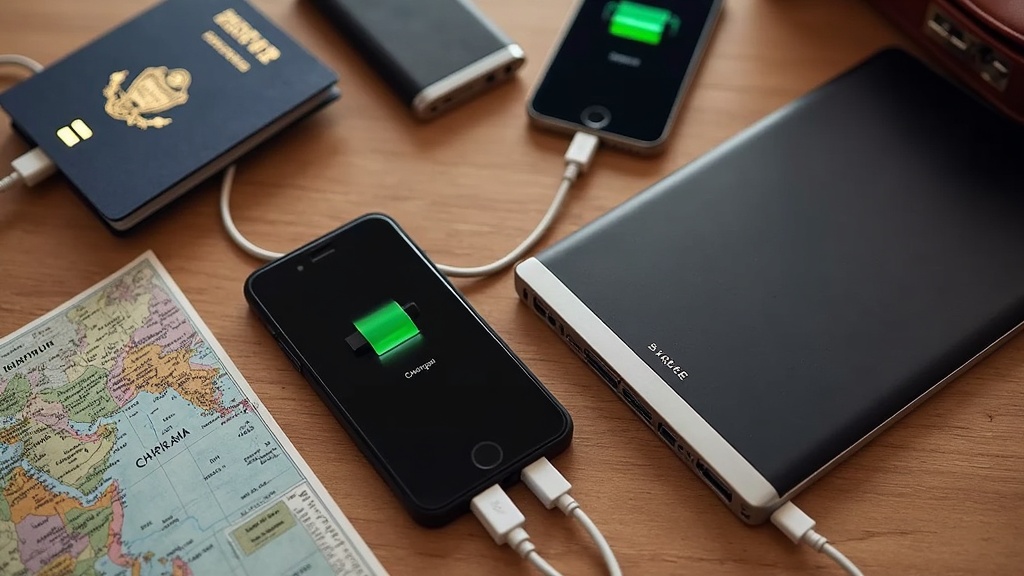Portable chargers have become almost as important as our phones and tablets, especially when traveling. With all the specs and options out there, finding one that meets your needs often feels confusing . Maybe you’ve put plenty of chargers through their paces on road trips, flights, and weekend getaways, so here are some tips to help make choosing the right one a whole lot easier. Here’s everything you need to know to stumble upon the best portable charger for your next adventure.

Why a Portable Charger Belongs in Your Travel Kit
Anyone who’s ever watched their battery level dip on a long flight or sightseeing tour knows just how handy a portable charger can be. When you’re snapping travel pics, finding your way around new cities or staying connected, a decent power bank really saves the day. As we use more and more devices, demand for power banks keeps spreading like wildfire—experts estimate the global market could top $15 billion in just a few years. It’s pretty clear: most travelers find that packing a portable charger helps way more often than they expect.
The first portable chargers hit the scene as chunky, low-capacity units that weren’t exactly easy to toss in a bag. Thankfully, new models are a far cry from those days. They come in way more compact designs and pack powerful batteries for almost every situation. Whether you’re charging a phone several times or keeping a laptop going for work or entertainment, there’s a charger out there that will have your back.
How to Pick the Right Portable Charger for Your Needs
Choosing the right charger starts by getting clear on a few key things:
- Capacity (mAh): This tells you how much charge a power bank holds. Bigger numbers mean more charges. If you want to power up your phone multiple times, look for at least a 10,000mAh battery. Tablets or laptops typically need something over 20,000mAh.
- Size and Weight: Backpackers and people packing light should know even a little extra weight adds up. Some chargers fit in your pocket—others are closer to a small paperback book. Think about what you’ll be willing to carry all day long.
- Output Power (Watts or Amps): Fast charging rules when you’re in a rush. Find chargers that back up Quick Charge, Power Delivery (PD), or other rapid charging standards if your device supports them.
- Number and Type of Ports: Want to charge a couple of things at once? The best power banks have a mix of USB, USB-C, or even AC outlets for different gadgets.
- Recharge Time: Juice up times vary. High-capacity chargers take longer to recharge, so options like USB-C input or passthrough charging (where you top off both the bank and your device together) are super helpful.
- Build Quality and Durability: Heading outdoors or into uncertain weather? A rugged or water resistant model will soak up bumps and splashes better than standard ones.
Thinking about these basics will quickly filter out a lot of choices before you even shop.
Handy Steps to Choose the Best Portable Charger
From a bunch of trial and error, here are five straightforward steps to nail down the perfect charger every time:
- Figure Out Your Charging Needs: List your must-have gadgets—phone, tablet, wireless earbuds, camera, or laptop. Match their battery sizes (in mAh) to the charger you’re considering.
- Decide on Portability vs. Capacity: There’s always a tradeoff. A tiny charger is easy to stash but might only give your phone a boost. Bigger ones carry more power but weigh more, giving you multiple charges on longer trips.
- Look for Fast Charging: If you hate waiting around at airports, pick a charger that uses Power Delivery, Quick Charge, or other rapid charging formats.
- Check the Ports: Check for compatibility with your cables, or see if it comes with extras. More ports make sharing power a breeze.
- Think About Extras: Features like built-in cables, fold-out plugs, or even an LED flashlight can make travel unexpectedly easier.
Sticking with this plan has saved me plenty of hassle and many frantic searches for an outlet or another lost adapter.
Things You Should Think About Before Buying
Chargers often look great online, but a couple of extra details can make one model a travel champ over another:
- Airline CarryOn Limits: Airlines limit the size of lithium batteries (usually up to 27,000mAh in your carryon). Doublecheck your charger’s size, especially if flying internationally, so you sail through security.
- Safety Features: Overcharge protection, temperature regulation, and short-circuit defense aren’t flashy but are key for avoiding problems. Reliable power banks list these features somewhere in the details.
- Warranty and Brand Support: Solid brands offer much better warranties and service if things go wrong. I find brands with quick email replies or a proven record of replacing defective units bring peace of mind.
- Charging Style: Wireless charging banks mean fewer cables, although charging speeds drop a bit. If convenience tops speed, these are worth trying out.
- Solar Charging: Power banks with built-in solar panels come in handy in emergencies or remote locations; just remember that sunlight charges are super slow, so think of this as a fallback, not your main plan.
Capacity: How Much is Enough?
If charging a single phone is the goal, a 5,000–10,000mAh bank will usually do. For two or three gadgets, or a phone plus a tablet, jump to the 15,000–20,000mAh range. For laptops or a group’s gear, shoot for 25,000mAh or more to keep everyone going.
Charge Time and Output Power
Rapid charging can truly be a gamechanger. Recent power banks can get your phone to 50% in under half an hour if you use Power Delivery or similar. Matching your bank’s charging tech to your gadgets speeds everything up, which matters when you’re in transit and every minute counts.
Durability for Adventurers
If your trips include lots of hiking or are off the beaten path, choose a rugged, water resistant model (look for IP54 or higher). Rubber coatings guard against drops, and built-in cables cut clutter and lessen the chance of leaving something behind.
Many common headaches—like slow charging or running out of ports—are easy to steer clear of with a bit of extra planning.
Advanced Tips When Shopping for a Travel Power Bank
Once you’ve locked down capacity and charging needs, these extras give certain chargers a real edge:
Check the Real Output: The mAh you see is measured at the bank’s battery voltage (often 3.7V), not your device’s (5V). Some juice gets lost during conversion, so expect real-world results to come out a bit less than the label says.
Passthrough Charging: Some power banks recharge themselves while charging another device. That’s a lifesaver in places with limited outlets, like airports or hostels.
Consider Accessories: Packing a short and tough charging cable (USB-C or Lightning) is smart—better than using the thin, easily damaged cable from your original box. Some travel cases fit both your bank and cables together, giving you one less thing to forget or lose.
Watch Out for Counterfeits: Cheap knockoffs with fake ratings and no safety testing pop up all the time. Buy only from legit stores or the manufacturer’s site to avoid issues.
Travel Scenarios and Real-World Examples
A smart portable charger pays for itself across all sorts of trips:
- Catching Flights and Layovers: Streaming, music, and GPS all drain your battery fast. A midrange power bank keeps your phone in the green through long layovers without weighing you down.
- Outdoor Adventures: Long hikes or camping call for high capacity, rugged power banks that let you charge your phone, camera, and essential gear for days without needing a wall outlet.
- Traveling as a Group: Packing a charger with multiple ports makes group trips stress-free, ensuring everyone can top off their devices for photos or directions—way simpler than each person carrying a tiny bank.
- Business Trips: Rapid charging is a big help when you’re moving between meetings, and a USB-C port powers up modern laptops, keeping you productive anywhere.
Frequently Asked Questions
Here are the most common questions I get from fellow travelers or first-timers buying their first power bank:
Question: Do airlines allow portable chargers in carry-on?
Answer: Yes, but only in carryon bags and usually under 27,000mAh per battery. Always check your airline’s current rules so you don’t face any surprises at security.
Question: How do I know if my devices will charge fast?
Answer: Both your device and your charger need to support the same fast-charging protocol (like PD or Quick Charge). Check your phone’s specs and match it with a compatible bank for the quickest charging possible.
Question: Are solar-powered power banks worth it?
Answer: They’re ok as a backup, but they’ll take a long time to fill up purely from sunlight. Rely on them just in emergencies or for longer trips off-grid.
Wrapping up: Picking the Best Portable Charger
Picking out the best portable charger for your travels mostly comes down to figuring out what you really need and where you’ll actually use it. If you spend a little extra time upfront thinking these through, you’ll track down a power bank that makes any trip easier, safer, and much less stressful. With so many solid options on the market, there’s definitely one that will fit right into your routine and keep you powered up wherever you roam.
